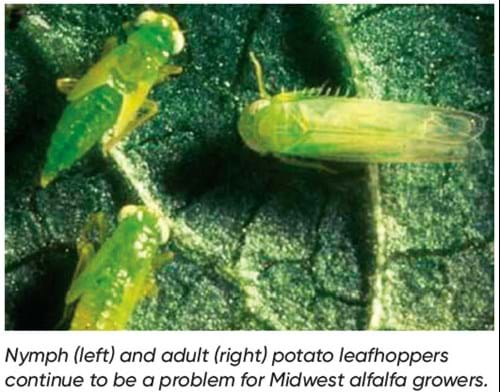Potato Leafhopper
BY Dairyland Seed Agronomy Team
Overview
In Midwest alfalfa fields, potato leafhoppers can cause significant problems for alfalfa growers by reducing yield, quality and stand longevity. Scouting alfalfa stands for these pests is crucial to alleviating future headaches.

What you should know:
- Midwest alfalfa growers can optimize alfalfa yields by accurately assessing potato leafhopper infestations and taking appropriate action.
- Potato leafhoppers live year-round in the Gulf Coast region. Each spring, weather fronts carry adult leafhoppers north to Midwestern fields.
- Most leafhopper damage occurs mid-June to mid-August. Monitor fields weekly following the first cutting until the end of the season.
- Harvesting alfalfa can eliminate leafhopper eggs already laid in stems, suppress the nymph population and displace adults.
- To optimize alfalfa yields, consider timely application of foliar insecticide treatment.
Action steps:
- Identify the pest: Leafhopper nymphs are yellow and do not have wings. Adult potato leafhoppers are about 1/8 inch long with yellow-green wings. Both adults and nymphs are wedge-shaped. Eggs are clear and can be found in the alfalfa stem.
- Scout for leafhoppers: Potato leafhoppers appear in alfalfa fields when the first cutting of alfalfa is nearing harvest. Look for yellow triangles on the leaves and stunted plants. Alfalfa also may turn a reddish or purplish color as a result of an infestation.
- Evaluate harvest schedule: If leafhopper populations are above economic thresholds, a timely harvest will reduce populations.
- Consider insecticide treatment: If a potato leafhopper population has reached the economic threshold, timely application of foliar insecticide may be warranted.
30-Second Summary:
- Potato leafhoppers can affect the quality and yield of Midwestern alfalfa stands.
- Scout fields regularly for infestation, starting after your first cutting.
- Timely harvest and use of insecticides can reduce leafhopper populations

Brian Weller
Western Region
507.456.3034

Rod Moran
Western Region
507.456.3034

Dan Ritter
Central Region
219.863.0583

Branden Furseth
Northern Region
608.513.4265

Mark Gibson
Eastern Region
260.330.8968

Amanda Goffnett
Eastern Region
989.400.3793

Ryan Mueller
Eastern Region
989.400.3793
